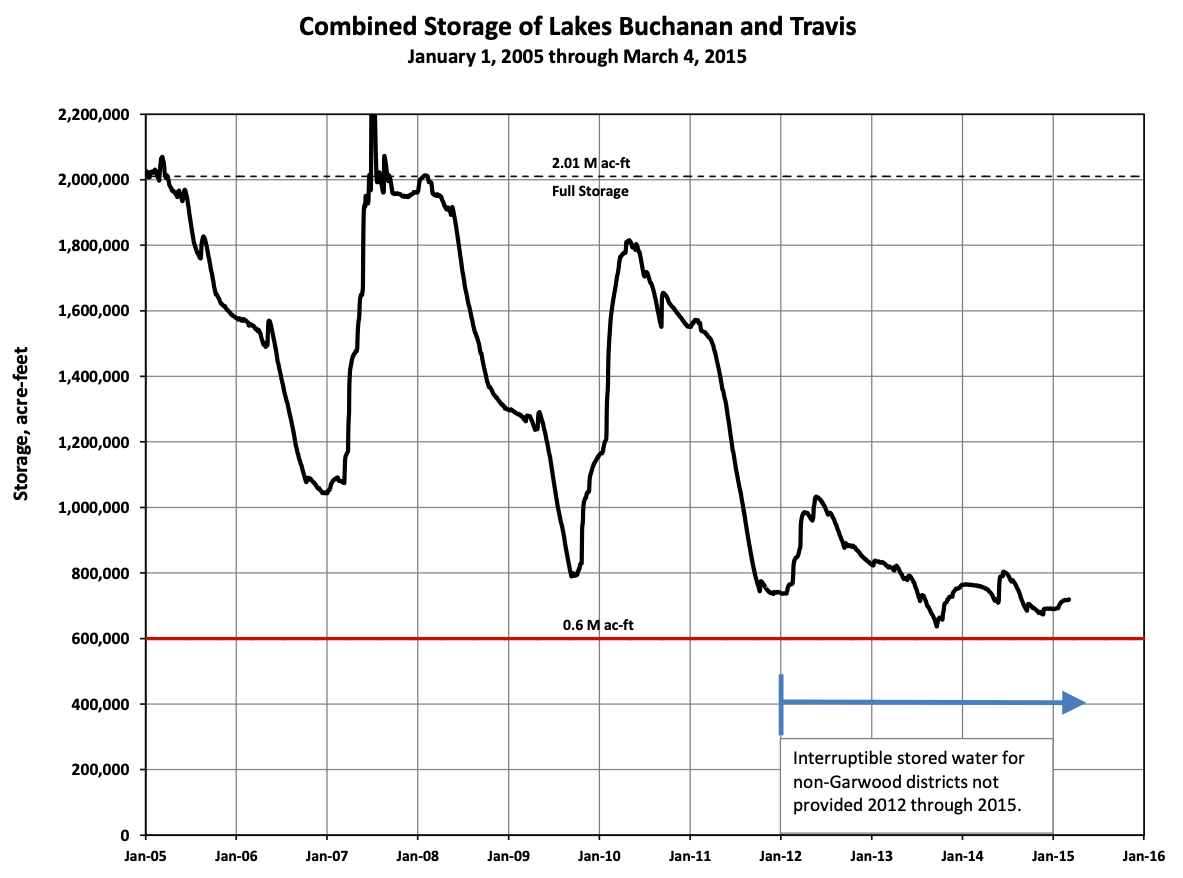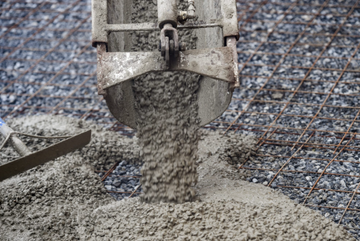☀️ Hey there, Austin.
🚨 New segment alert 🚨 Starting now, we're going to be including a crossword every day. Get hyped for some early morning mental stimulation.
But first, let's dive into the future of our city's water supply and why 2008 through 2016 kicked Austin into gear to find a solution.
Then, read how robot street sweepers could be part of the city's plans to be zero-waste by 2040. And peep what you can see written on Tesla's Gigafactory from way up high.
When the river runs dry
Let’s talk water, folks.
We kinda like, you know, need it.
And so will all the folks who will keep moving to Austin next year and the year after that and the year after that and the year aft—
But here’s the thing: In the past couple of decades, people have grown more and more worried about the future of Austin’s water supply.
Why? Let’s dive into that. Then we’ll lay out what the city’s doing to make sure there’s enough to go around (and then some) in the coming decades.
Austin went through some sh*t from 2008 to 2016
The city has gotten its water from one source since 1871: the Colorado River. Austin Water has three treatment plants that process the water so we can drink it.
But that supply sank scarily low when an eight-year string of droughts left lakes like Lake Travis (which the Colorado flows into) at one-third their full capacities.
Take 2011, when there were 127,801 total acre-feet that year (acre-feet = the amount of water it takes for an acre of land to be 1 foot deep). That’s 10% of what the average usually was, Austin Water said in 2015.

For comparison, the lakes saw 501,926 acre-feet in annual inflow during the droughts from 1950 to 1957. This is also when those Sometimes Islands started popping up in Lake Travis. If you’ve been to the Oasis during a dry spell, you’ve seen them from the patio.
The first- and second-lowest monthly Lake Travis levels were in 1951 and 1952, according to data from the Lower Colorado River Authority (LCRA). But the third-lowest was in September 2013, when the lake dropped to 618 msl (mean sea level). That’s 62 msl below full capacity.
All of which is to say: The entire ordeal shook city leaders up a bit, and they realized they couldn’t put all their eggs in one basket. Or water in one … bucket … you get the idea.
Water Forward, GoPurple and storing water underground
- In 2018, two years after the droughts tapered off, Austin City Council approved Water Forward.
It’s Austin Water’s plan devoted to making sure the city has a solid water supply for the next 100 years (it’ll be updated about every five years starting this year).
Water Forward is all about:
💧Diversifying Austin’s water supply and keeping it sustainable and reliable
💧Being smart about water conservation and reuse
💧Avoiding severe water shortages when a drought comes along
Hear, hear on that last one.
The next two plans are part of Water Forward.
- Let’s get purple-y
Austin Water started setting up a network of purple-colored pipes in the 1990s that were meant to reuse water for yard irrigation and other non-drinking uses.
Well, in early March, City Council green-lit a program that would require 250,000-square-foot buildings in the city within 500 feet of those pipes to tap into that reclaiming system. If they don’t, they’ll have to build some sort of on-site water reuse center.
This A) helps recycle 16 million gallons of combined potable and non-potable water a day and B) helps the city avoid up to $10 million in fees. If Austin uses more than a certain amount of water for two years in a row, then it owes the LCRA a pretty penny.
GoPurple adds an extra $1.47 to everyone’s monthly water bill.
- Storing water underground instead of in reservoirs
The idea is that water stored underground in aquifers will evaporate less than if it's stored above ground in a lake like Travis. We don’t need to tell you how hot and humid it can get here …
Austin Water is toying with having this project going by 2040, the group told KVUE in December. A rep likened it to a savings account that you could pull water from as needed.
We’ll see how these plans pan out. At the moment, at least we know the lake is nice and full: March through June is when it's historically the highest.
Perfect for boating season. 😎
Shoutout to our reader Larry L. for his email with concerns about the city's water supply. What other topics do y'all want to see us dive into? Reply to this email and let us know.
— Katie Canales, Editor

Temperature: 79 degrees | Sun: Making a comeback | What to Expect: Refreshing air
Do you feel that? Aaaahhh. After days of humidity and warmer-than-normal temperatures, a cold front moved through this morning with breezy winds, lots of sunshine and lower humidity.
Mary’s Tip: A stroll around Town Lake sounds nice right about now. Is it 5 p.m. yet?

Welcome to our new weekly section: Sustainable Austin
From City Hall to individual Austinites, this city is full of programs and people trying to help make life in Austin more sustainable. And we think that’s an important effort. So each week we’ll be dedicating a corner of this newsletter to exploring the good, the bad and the ugly of how Austin is trying to become a little less wasteful. Know a program, group or individual doing something you think we should write about? Send me an email at cat.delaura@austindaily.com.
For today’s topic, we’re starting with the basics: Austin’s Zero Waste by 2040 goals.
Despite an original goal of diverting 75% of material from the landfills by 2020, Austin is currently only diverting 40% of materials. (We were supposed to have hit 50% in 2015.) Last November, Austin adopted an updated version of the city’s plan for reaching that goal, which was originally passed in 2011.

Here are four goals outlined in the 2023 Austin Resource Recovery Comprehensive Plan:
- Finally, a North Austin Recycle and Reuse Drop-off facility: For any north-of-the-river Austinites, dropping off your hard to recycle and household hazardous waste usually means braving the cross-river traffic on I-35 to get to the center south of Highway 71. And let’s be honest that is sometimes all the disincentive you need to just not ever do it. The city seems to get that and has added a second north Austin location to its list of goals, although currently it remains just that — a goal.
- Did somebody say robot street sweeper? That’s right. Austin Resource Recovery isn’t immune to the autonomous vehicle craze sweeping the country (and coming close to home with Waymo’s fully autonomous cars being tested on our streets). The 2023 plan calls for exploring the possibility of using autonomous or unmanned technologies to sweep within protected bike lanes, parks or rights of way.
- New life for an old landfill? The old municipal landfill near FM 812 is currently being monitored in a 30-year post-closure care phase. But could our trash one day become a green space or hike-and-bike trail? That’s what the city wants to explore. One long-term goal is to research development options for the land, including a golf course, nature park or renewable energy generation, to name a few ideas. The ultimate goal is to use the land or funds from the land to support the city’s zero waste goal.
- Think that recycling bin can be your second trash can? Think twice. Roughly 20% of Austin’s curbside recycling is contaminated. To crackdown on that, the city is considering implementing a fee for customers who repeatedly contaminate. A number of other cities have tried implementing similar fees over the years.

Austin From Above: Hi from Tesla HQ
We’ve written about Elon Musk’s companies before. He has Tesla, Boring Company and SpaceX operations here in our fair city.
And Tesla’s Gigafactory off the 130 toll road has the architectural equivalent of a vanity license plate: the company’s name scrawled on the top of the facility for all the world’s satellites to see.

The name is actually negative space among a cluster of ~70,000 solar panels that were installed on the factory's rooftop. That power will help run Giga Texas.
The idea, per a Travis County meeting in October, was to eventually generate 30 megawatts of energy from the panels.
It's just icing on the cake then that it ~~~looks cool~~~.

Wrong and Right
Welcome to your first crossword, Austin Dailies. Each day we’ll give you a clue to one of the answers.
Today’s clue for 30 Down: what kind of brew is Electric Jellyfish AKA some of the best hops Austin has to offer? (Hint: the answer is in "IPA.")


We’re so glad you found us. Find our bios and contact info here, or reach out at hello@austindaily.com. Behind today’s send: Katie Canales, Cat DeLaura and Mary Wasson.


